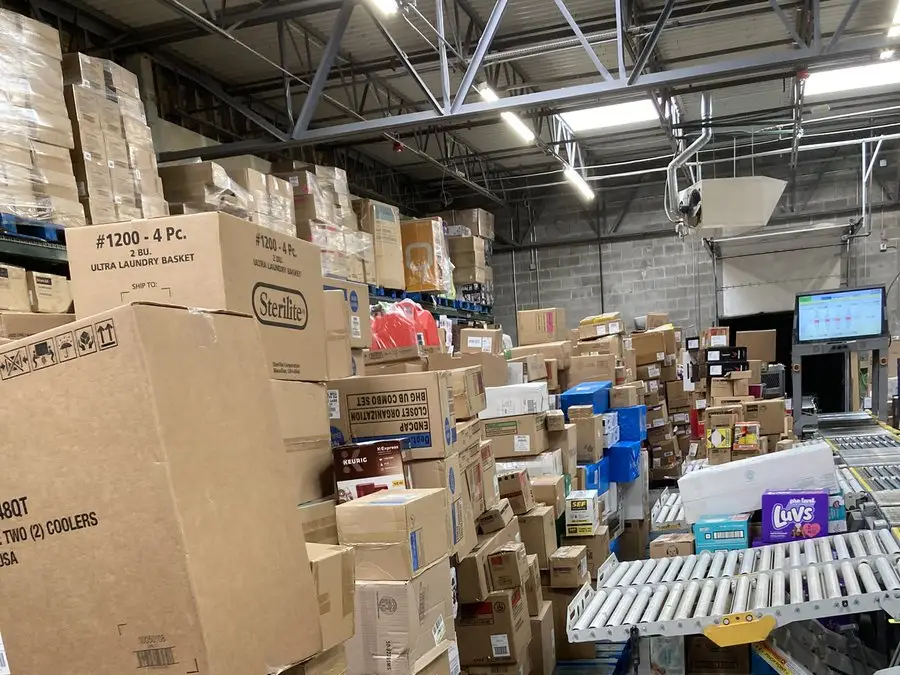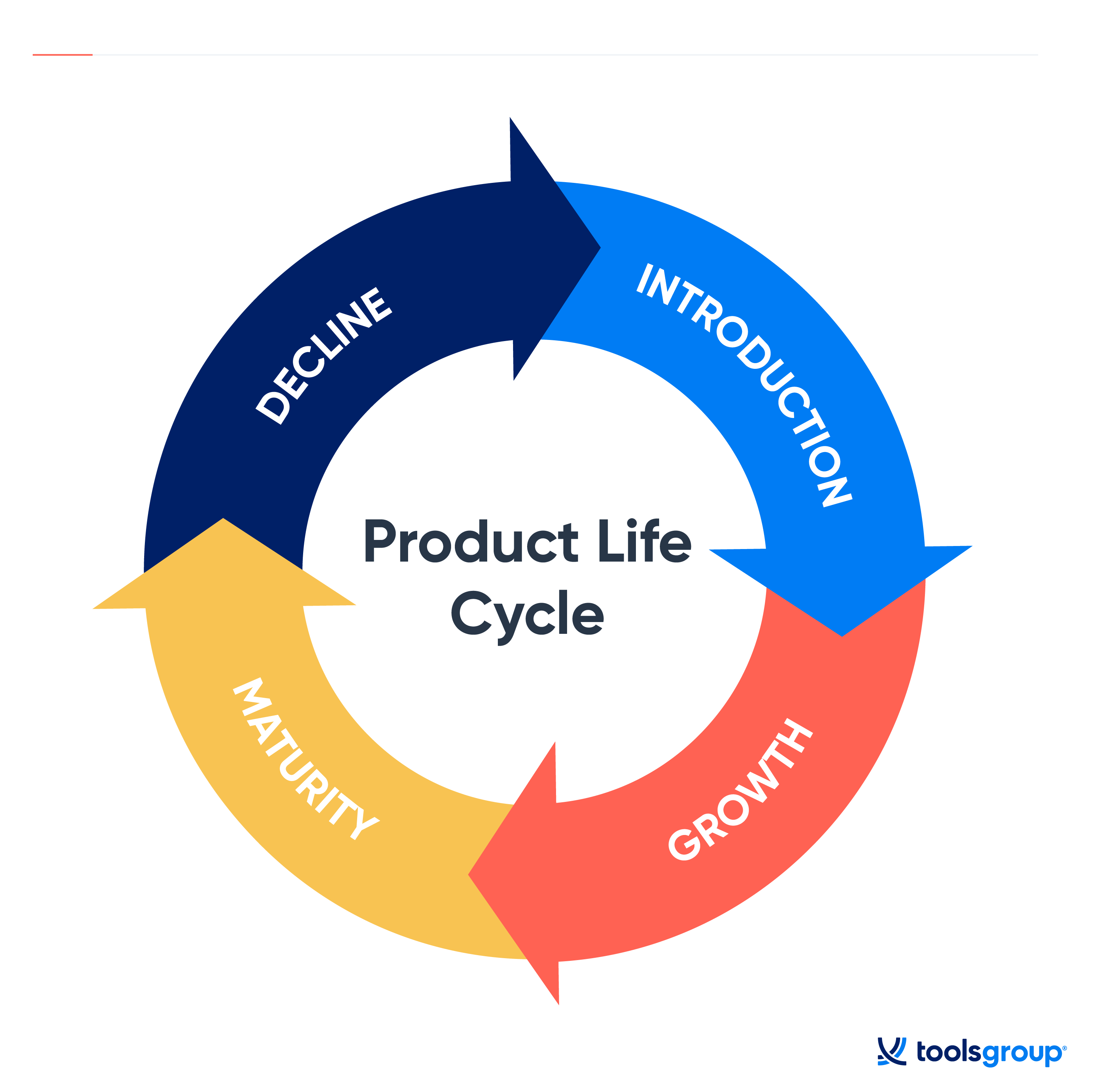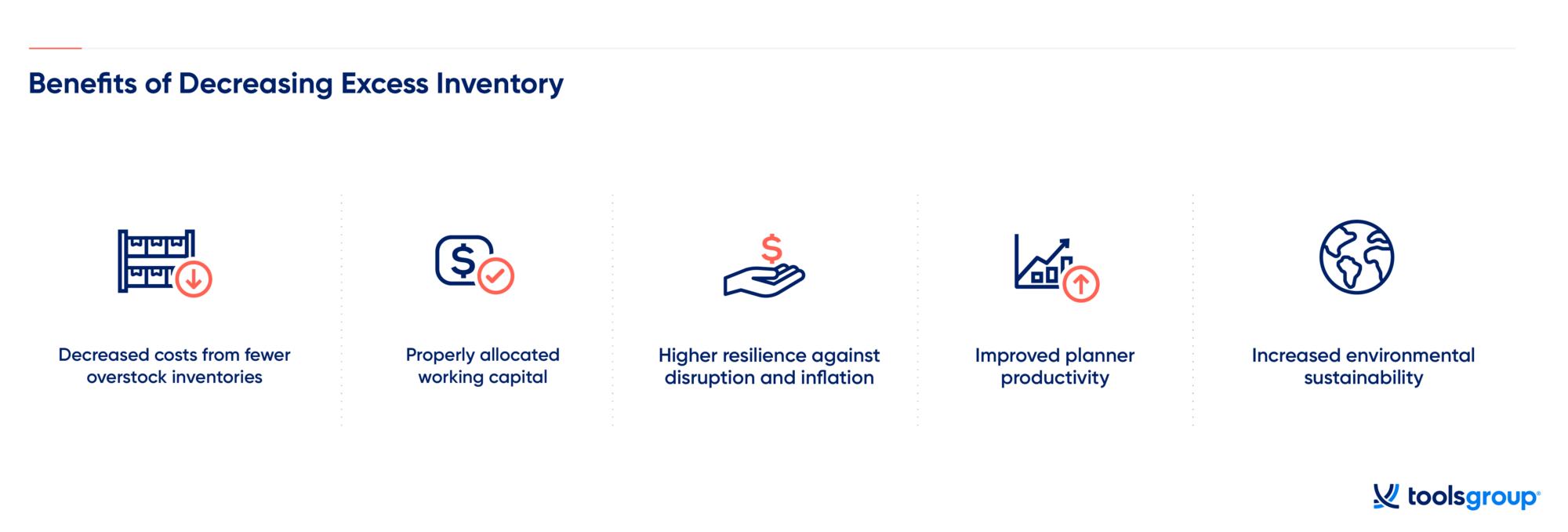Excess inventory – it’s taking up your warehouse space, tying up working capital, and limiting your planning team’s range of motion.
It’s time to Marie Kondo your supply chain by eliminating excess inventory and learning how to avoid it in the first place.
Let’s talk about:
What is Excess Inventory?
Excess inventory is the stock remaining on shelves or in warehouses after customer demand for an item has been filled.
Perhaps it’s a leftover seasonal product (like candy corn at Christmas), or perhaps planners simply ordered too much.
However you end up with it, no one wants to be stuck with surplus stock, but even large corporations are falling prey to it.
Due to Covid-era over-ordering, Target was forced to offer massive discounts to move inventory, causing a devastating almost 90% drop in profits in the second quarter of 2022.
Walmart found itself in a similar situation, facing an inventory increase of 32%. Employees reported that the number of pallets on the floor had rendered storage spaces unnavigable.

Source: Insider
7 Causes of Excess Stock
So how did it come to this?
Let’s dig into the top reasons businesses find themselves buried under excess stock.
1. Shipment Delays and Supply Chain Disruptions
From weather to war to congested ports, it’s no secret that ongoing supply chain disruptions cause delays, shortages, and extended lead times.
Those supply shortages lead to stockouts. So how do those stockours lead to overstock?
Let’s say an inventory shipment from your supplier is delayed.
If that shipment arrives too late, the resulting stockout could make you miss your window of opportunity, especially for seasonal products. It’s possible that in the meantime, consumers have gone elsewhere to make their purchases, and demand has diminished before you could capitalize on it.
In fact, when a store is out-of-stock for an item they planned to buy, 21% of consumers will leave and buy the item from a competitor.
So the delay has left you with lost sales and leftover inventory.
Bloated safety stock orders compound this issue.
Over the past few years, as disruptions became more prevalent, severe, and persistent, planners tended to give themselves what they assumed was a reasonable inventory buffer.
That safety stock can become a nightmare glut of inventory–like it did for Walmart and Target.
2. Internal Logistical Issues
Logistical obstacles include internal complications like a truck or driver shortage, or an infrastructure stretched beyond its capacity to service all your locations.
In the world of Amazon two-day shipping, customers expect availability and speedy service, and meeting those expectations is pivotal for a competitive supply chain.
Any logistical difficulties can cause canceled orders or drive customers to competitors who have items in stock and available in-store or for rapid delivery, leaving you with excess inventory stuck on trucks or waiting in warehouses.
Don’t let supply chain disruptions and outdated planning solutions stifle your business.
Access the Guide to Overcoming Inventory Disruption and discover 10 ways to keep service levels and profits high and inventory costs low.

3. Inaccurate Demand Forecasting
Without the right technology and approach to support then, forecasts have the unfortunate tendency of being wrong.
If they’re based on excel spreadsheets that can’t process and incorporate crucial demand-related data, they leave plenty of room for human error.
Even if you implement a forecasting solution, it may not be as data-driven as you think.
For instance, traditional forecasts are calculated from the top down, meaning they aggregate all your demand, average it, and then apply that number across the board.
This approach misses a lot of the important granular information–like how much and where an item was purchased–that provides a more in-depth analysis of your demand picture.
Traditional forecasting is also “deterministic,” meaning it gives you just one number and tells you, “this is exactly the amount of stock you’ll need.” That number will most likely be off, but you don’t know by how much.
Without a clear understanding of demand, you could very well end up sending lots of inventory to the wrong places.

Factors like seasonal demand and the product life cycle exacerbate this issue.
Seasonal Demand
Seasonal demand applies to products associated with specific periods or events throughout the year, causing demand to fluctuate.
Forecasting seasonal demand is tricky. You want enough stock early enough to capitalize on the season, but you need to sense the post-season demand drop-off to know when to reduce your inventory levels.
You don’t want to end up with stock you won’t be able to move until the season rolls around again.
Product Lifecycle
Beginning with new product introduction (when you have little or no demand history to guide stocking decisions) and ending with product retirement, the product life cycle goes through a series of phases, each with shifting demand behaviors.

The difficulty isn’t just that demand changes; it’s knowing when a product is transitioning from one phase to the next so you can avoid ordering too little or too much inventory.
While product forecasting is less of an issue for perennial products, trendy items or items with an expiration date need to be handled and forecasted with care to avoid overstocks.
Learn how to avoid the most common mistakes that obscure demand.
Discover the key tools and strategies to help you effectively sense demand and best position your products as they move through the product life cycle.
Check out Product Forecasting: Understanding Demand Throughout the Product Life Cycle →
4. Poor Inventory Management
Imbalanced inventory often stems from a cookie-cutter approach to inventory planning.
Prudent tradeoffs between how much you invest in inventory and how high you set your service levels make it possible to maintain a happy customer base without inventory being stacked to the rafters.
But outdated planning strategies treat SKUs as though they have the same (and often very high) service requirements.
This doesn’t account for differences in demand among products and often tips that balance between service and stock levels too far in one direction.
This either leaves you with depleted inventory and lost sales, or swallows up your working capital in excess stock.
5. Technical Challenges
Does it ever feel like your tech stack is stacked against you?
Out-of-sync processes, hampered by siloed planning and poorly integrated systems, leave you with fragmented data and offer very little visibility for making smart inventory decisions.
If your team is making decisions in the dark, the ripple effects can result in stock surplus, financial underperformance, and a lot of headaches for your employees.
This is especially true for omnichannel operations who are fulfilling demand through multiple channels and need to ensure inventory is positioned efficiently for rapid fulfillment.
6. Retail Returns
Remember all that inventory you moved in November and December for the holidays?
Well, now it’s January and you have to contend with all the returns.
In fact, in 2021, retailers experienced average return rates of more than 16%, as opposed to 10.6% in 2020.

And depending on your return policies, those items might not all be going back to their original warehouse.
If you’re a retailer who allows online purchases to be returned in-store, those incoming items are going to take up valuable space on racks and in storage rooms.
They can also throw off your localized assortment, leaving you with inventory that doesn’t align with regional or store-specific demand behavior.
Building a profitable assortment requires collaboration across departments.
With the Ultimate Assortment Planning Checklist, learn how to identify stakeholders, employ data-driven strategies to align on goals, and create an assortment that will delight customers and boost profitability.

7. Expiring or Perishable Product Types
Some products need to move more quickly because they have an expiration date, such as food or medicines. This can affect you on both sides of production.
Perhaps the raw materials you use in manufacturing are perishable and therefore you have to balance production speed and desired output with shelf life.
If your finished goods have an expiry date, you need to be careful about how much you make or order so you don’t hurt your pockets–or the planet.
You want to avoid having to dispose of expired stock or offering a deep discount to move it in time.
The Disadvantages of Excess Stock
There are four major downsides to surplus stock, and the repercussions of them can make or break your supply chain.
Storage Limitations and Costs
If you have leftover inventory, you need a place to put it.
You can only leave it on store shelves for so long before you need room for newer or more in-demand products. And if you leave it too long, this sluggishness in inventory variability can endanger customer satisfaction.
If you keep your surplus stock in a warehouse, you have less storage space for the rest of your portfolio, restricting how economically and nimbly you can manage your inventory.
Plus, you may also incur additional storage costs that rapidly eat away at your profit margins.
Reduced Profits and Stunted Business Growth
If you’re not selling a product, you’re not recouping the cost of making it.
This reduced cash flow limits your flexibility and restricts how much capital you can invest in other revenue-driving business initiatives, such as new products that will freshen up your assortment, bringing in new customers or keeping old ones coming back.
Increased Risk of Product Obsolescence
With the rate of product development, if a product doesn’t sell the first go round, it may not sell much ever again.
In fact, according to one study, 95% of the over 30,000 new products introduced every year fail. This may be due to poor development, poor promotion, or just lack of consumer interest.
The risk of obsolete inventory makes it imperative to align teams across departments from development to promotion, and plan stock levels accordingly.
And considering many products have planned obsolescence, consider carefully how much you’re ordering to meet demand.
Wastage
The natural effect of product obsolescence and expiration is wastage–those products that cannot be stored indefinitely and are just thrown away.
Not only is this a financial investment you can never recoup, but it’s a huge environmental issue as well.
In the case of planned obsolescence, the world produced 59 million US tons of waste in 2019.
Data-Driven Ways to Calcualte Surplus Inventory
Sometimes, excess inventory is scattered throughout your network and it can be difficult to get a full picture of your overstock in warehouses. Other times, you know what isn’t selling because it’s been lurking at the end of an aisle for weeks now.
But we love a data-driven approach that gives you concrete numbers that help you develop, communicate, and measure the effectiveness of better management strategies.
So here are four ways to spot and quantify your excess stock.
1. Consider your usage of available space.
The equation above calculates how well you’re using your store space by measuring how many sales are generated per square foot. You can also apply this to each department or section of your store.
The higher the number of sales per square foot, the better.
This can highlight the areas or departments that are underperforming compared to the rest of your merchandise.
2. Consider how long you’re holding onto inventory.

Days Inventory Outstanding (DIO) is a ratio that measures the average number of days you’re holding onto inventory before you sell it.
The lower the number, the fewer days those items are spending on the rack or in the aisles.
3. Calculate how fast your products are selling.
Your inventory turnover is the brother of DIO, but instead of measuring how long you’re holding onto stock, it measures how fast you’re selling it.
The higher the ratio, the faster you’re converting inventory into sales.
5 Strategies for Preventing Excess Stock
So what can you do to minimize excess stock?
Here are four steps you can take to optimize inventory across channels.
1. Automate and incorporate AI into your planning processes.
The overall step in the right direction is leveraging technology and implementing an effective digital transformation strategy.
Basic automation takes the leg-work (and stress) out of planning.
Does this scenario sound familiar?
“We had three spreadsheets, and our business relied on them. Every day, the operations and finance teams prayed the files remained stable and stayed linked. Anytime something went wrong, it was an all-hands emergency to fix.”
That’s Jim Schreiber, the Vice President of Operations at StoreBound, the fastest growing houseware company in the US. He has experienced the struggle of spreadsheets.
By ditching the spreadsheets and automating its planning process, StoreBound now generates more accurate forecasts and has optimized its inventory, setting up a system that can support its expanding network and business.
Better forecasts lead to right-sized inventory, meaning you don’t get left with pesky excess stock.
Digitalizing your planning process toughens up your supply chain while increasing its flexibility and sharpening its reflexing against disruptions.
Get your free copy of the 2022 Digital Transformation Survey to learn how companies worldwide are fortifying their supply chains with smart investments in innovative technology.

Automation is only one piece of it, though.
Artificial intelligence enables savvy planning.
Retailers, manufacturers, and distributors are turning to artificial intelligence to manage increasing complexity and uncertainty.
By applying AI to forecasting and inventory practices, planners can make smarter, faster inventory decisions to help them deliver on their promises to customers while keeping stock levels from getting out of hand.
AI also spares your planners the grind of manual calculations and unwieldy spreadsheets, frees them from jumbled data, and gives them time to pour their expertise into activities that help both them and your business grow.
Handpicked related content:
2. Get your teams – and data – aligned.
Automated solutions don’t just make the data processes easier.
They provide your company with a single source of truth that synchronizes operations across teams, breaking down silos and facilitating collaboration.
With greater visibility across your supply chain, you can align strategic goals with tactical maneuvers and balance the needs and goals of various departments, making sure your inventory is sized and positioned optimally to meet demand in each location,.
3. Rethink your forecasting strategy.
Need a clearer understanding of your demand so you only buy what you need? Try an adaptive probabilistic approach.
Unlike traditional forecasting methods, probabilistic forecasting doesn’t just use demand history.
It also accounts for external variables like weather and incorporates demand-related details like where and how much of an item was purchased at a time.
Using a powerful machine learning engine, it gives you a range of outcomes to consider and tells you the likelihood of each outcome.
In this world of uncertainty and disruption, having a fuller picture of demand is vital for making smart, informed forecasting decisions to help you purchase only what you’ll need.
Probabilistic forecasting can dramatically increase your forecast accuracy–and your profit margins.
Learn more about how it can boost your business performance and right-size inventory despite uncertainty.
Open My Quick Guide to Probabilistic Forecasting →
4. Right-Size Your Inventory
With the advent of AI-powered planning solutions, planning teams can perform quick data analyses and optimize stock for each SKU across locations.
By reducing stock while still keeping service levels high, you’re satisfying demand and freeing up working capital, giving you greater cash flow for new product investments and other initiatives to drive business growth.
Plus, these machine learning solutions keep learning and self-adapting, increasing their accuracy and their value-add over time.
Check out The State of Retail Inventory and discover the secrets to meeting financial targets while ensuring a top-notch customer experience.

5. Collaborate with suppliers.
A healthy supply chain starts with strong communication between you and your suppliers.
Here are some signs of good communication:
- You know who your stakeholders are and have a designated person or team dedicated to nurturing that supplier relationship.
- You have established clear expectations about materials, data, lead times, and supply requirements.
- Your planning solution allows for transparency around forecasting and upcoming orders.
- You have established a regular cadence to gain feedback and review operations.
By opening and maintaining those channels of communication, both you and your suppliers can catch possible disruptions before they snowball, reducing stress on your supply chain and helping both of you make smart planning decisions.
How to Clear Out Excess Inventory
Knowing how to avoid excess stock levels is great, but what if you’ve already got some on hand?
Here are some strategies to help you clear your stores and warehouses:
- Offer Strategic Discounts: Shape consumer demand by offering special discounts and promotions.
- Bundle It: Include overstocked items in deals, offering customers more bang for their buck while clearing shelf space.
- Freshen Up Your Promotions: Remind people about your great product! Try gaining more exposure or switching up your promotional tactics to renew interest and stoke demand.
- Get Employees Onboard: Encourage employees to recommend the product to customers to drive sales.
- Exchange or Return Stock to the Supplier: Your supplier might be willing to take some materials or products back.
- Liquidate It: Sell your surplus to liquidation companies.
- Donate It: Consider giving away your excess stock to worthy causes.
- Recycle or Repurpose It: See if there is something else you can do with this product or consider how you might salvage materials from it for a different product.
- Implement a “Keep the Item” Return Policy: Considering the cost of returning an item and storing excess stock, some retailers allow customers to keep the item, while still processing the refund. It’s a tradeoff that might be worth it depending on your financial model and business size.
The Benefits of Healthy Inventory
Here’s the final takeaway. You take care of your inventory; it takes care of you.
Perhaps that means reevaluating your internal processes or logistical infrastructure.
Perhaps that means investing in the technologies that will help you stay innovative, creative, and competitive.
However you eliminate surplus stock and achieve a healthy inventory, you’ll find the benefits are worth it.

And these benefits are just the beginning.
Learn more about how a healthy inventory elevates your customer’s shopping experience, increases your competitive advantage, and boosts revenue.
Check out original research from ToolsGroup and retail advisory firm IHL, and discover How Retailers Win Customer Loyalty in an Omnichannel World.


